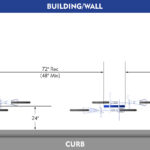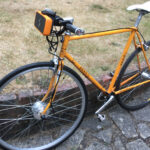How to buy your first bike? Buying your first bike can be exhilarating, but navigating the vast options available can be overwhelming. At usabikers.net, we simplify the process and offer you expert advice and resources to help you choose the perfect ride. Our guide will ensure that you find a bike that matches your lifestyle and preferences, so you can confidently hit the road or trails.
1. Define Your Riding Goals
What do you plan to do with your new bike? Defining your goals is the first crucial step. Identifying your primary use case will narrow down your choices and ensure you select a bike tailored to your specific needs.
Different types of bikes are designed for different purposes:
- Road Bikes: Ideal for speed and efficiency on paved roads.
- Mountain Bikes: Built to handle rough trails and off-road adventures.
- Hybrid Bikes: A versatile option for commuting, recreational riding, and light trails.
- Gravel Bikes: Perfect for exploring gravel roads, bike paths, and varied terrains.
- Folding Bikes: Designed for urban commuters needing portability and easy storage.
- City Bikes: Comfortable and practical for short urban trips and errands.
- Singlespeed/Fixie Bikes: Simple, low-maintenance options for flat urban areas.
Knowing your riding goals ensures you choose a bike that aligns perfectly with your intentions.
1.1 Commuting Considerations
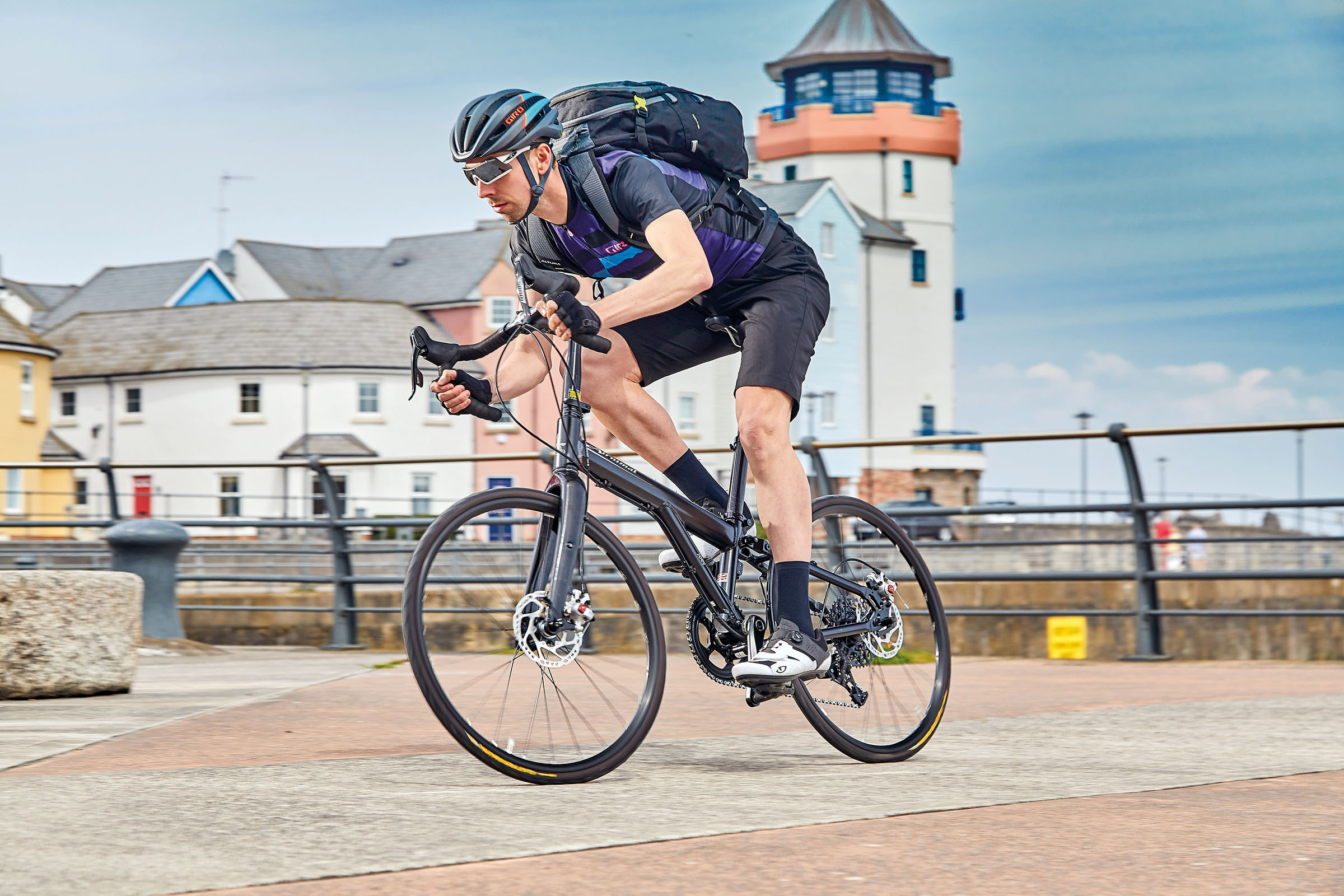 A male cycling on a blue bicycle on the harbour-side
A male cycling on a blue bicycle on the harbour-side
What is the best bike for commuting? For commuting, a hybrid bike’s upright riding position and versatility is ideal. Road bikes are also suitable, especially those designed with commuting in mind, featuring mounts for mudguards and racks.
Key features to consider for commuting:
- Mudguards: Essential for protecting yourself from rain and road spray.
- Rear Rack: Allows you to carry luggage comfortably, avoiding the strain of a backpack.
- Lights: Important for visibility, especially during early morning or late evening commutes.
- Comfortable Saddle: Crucial for longer rides to and from work.
- Puncture-Resistant Tires: Minimize the risk of flats during your daily commute.
According to the League of American Bicyclists, investing in a reliable commuting bike can significantly reduce transportation costs and improve personal health.
1.2 Road Riding Aspirations
What type of bike is best for road riding? Drop-bar bikes designed for covering ground quickly are best suited for road riding. Choose between race-oriented designs for an aggressive riding position or endurance bikes for a more upright posture.
Key features for road riding:
- Lightweight Frame: Enhances speed and agility on the road.
- Aerodynamic Design: Reduces wind resistance for faster riding.
- Efficient Gearing: Allows for smooth transitions and optimal performance.
- Comfortable Handlebars: Provides multiple hand positions to reduce fatigue.
- High-Pressure Tires: Minimizes rolling resistance for increased speed.
For non-racing cyclists, endurance road bikes offer a more relaxed geometry and versatile features like increased tire clearance and mounting points for mudguards and racks.
1.3 Trail Adventures
Is a mountain bike suitable for tackling trails? If you want to tackle trails, a mountain bike is undoubtedly the way to go. These bikes offer an upright position for control, fat tires for grip, a wide range of gears, and powerful brakes.
Key features for trail riding:
- Suspension System: Absorbs shocks and bumps for a smoother ride.
- Durable Frame: Withstands the rigors of off-road terrain.
- Powerful Brakes: Ensures reliable stopping power in challenging conditions.
- Wide, Knobby Tires: Provides excellent traction on loose surfaces.
- Wide Gear Range: Helps you conquer steep climbs and varied terrains.
According to the International Mountain Bicycling Association (IMBA), mountain biking is an excellent way to explore nature, improve fitness, and challenge yourself physically and mentally.
1.4 Exploring Gravel Roads
What is the advantage of riding a gravel bike? Gravel bikes bridge the gap between road and mountain bikes. They combine drop bars with chunky tires, allowing you to tackle various terrains like towpaths, gravel tracks, and roads.
Key features for gravel riding:
- Drop Bars: Provides multiple hand positions for comfort and control.
- Gravel Bike Tires: Offers grip and cushioning on rough surfaces.
- Durable Frame: Built to withstand the demands of off-road riding.
- Disc Brakes: Provides reliable stopping power in all conditions.
- Mounting Points: Allows you to carry gear for longer adventures.
Gravel biking opens up a world of exploration, allowing you to discover scenic routes and enjoy a mix of road and off-road riding.
1.5 Electric Bike Benefits
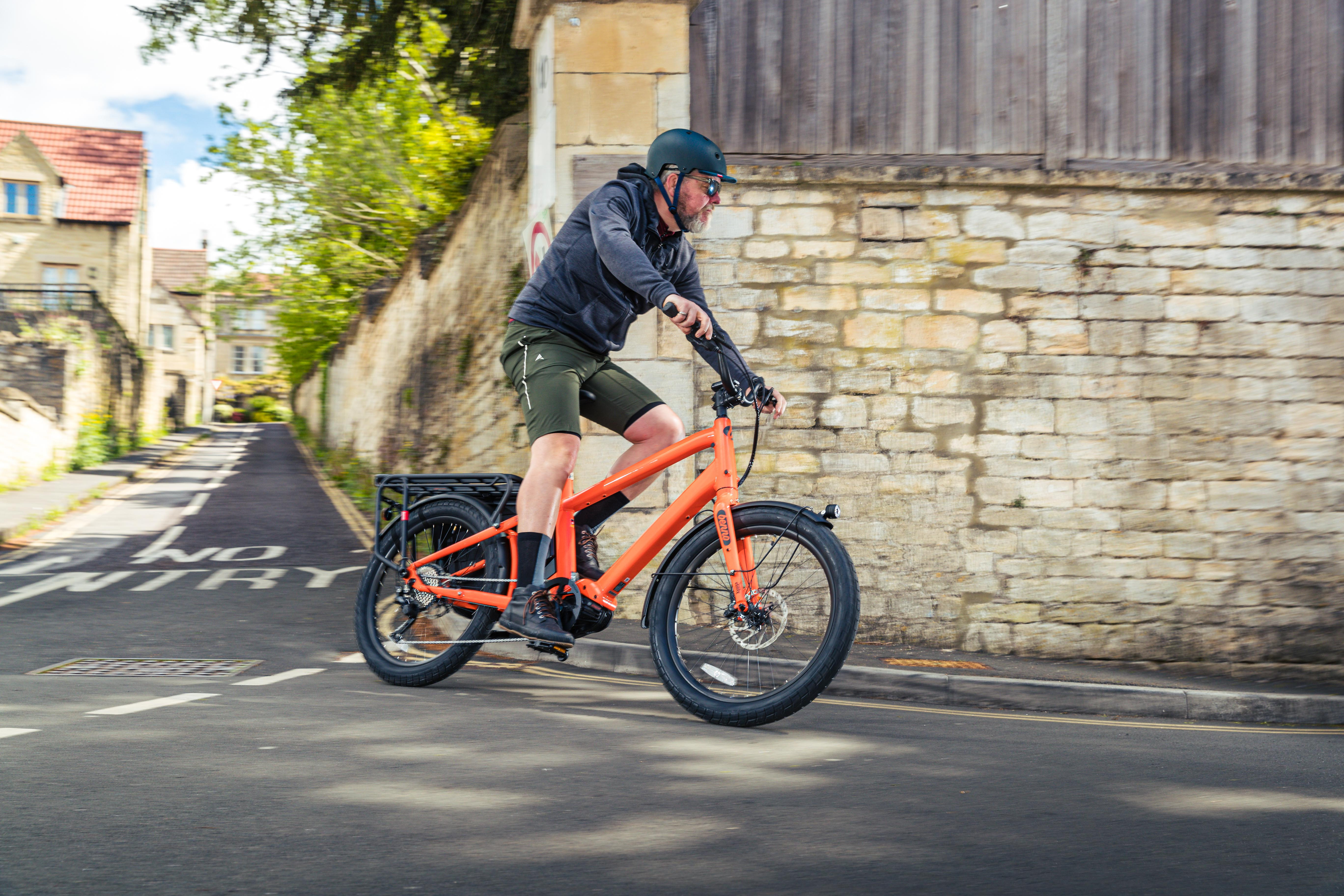 Electric versions are available for almost all bike types. – Immediate Media
Electric versions are available for almost all bike types. – Immediate Media
What is an electric bike? Electric bikes provide a boost to your pedaling power, making hills easier to climb and long distances more manageable. They are available in various styles, from hybrid to mountain bikes.
Key features for electric bikes:
- Motor: Provides assistance while pedaling.
- Battery: Powers the motor and determines the range of the bike.
- Controller: Allows you to adjust the level of assistance.
- Display: Shows battery level, speed, and other important information.
- Durable Components: Ensures reliability and longevity.
According to a study by the National Renewable Energy Laboratory (NREL), electric bikes can reduce carbon emissions and improve air quality compared to traditional transportation methods.
1.6 Urban Practicality
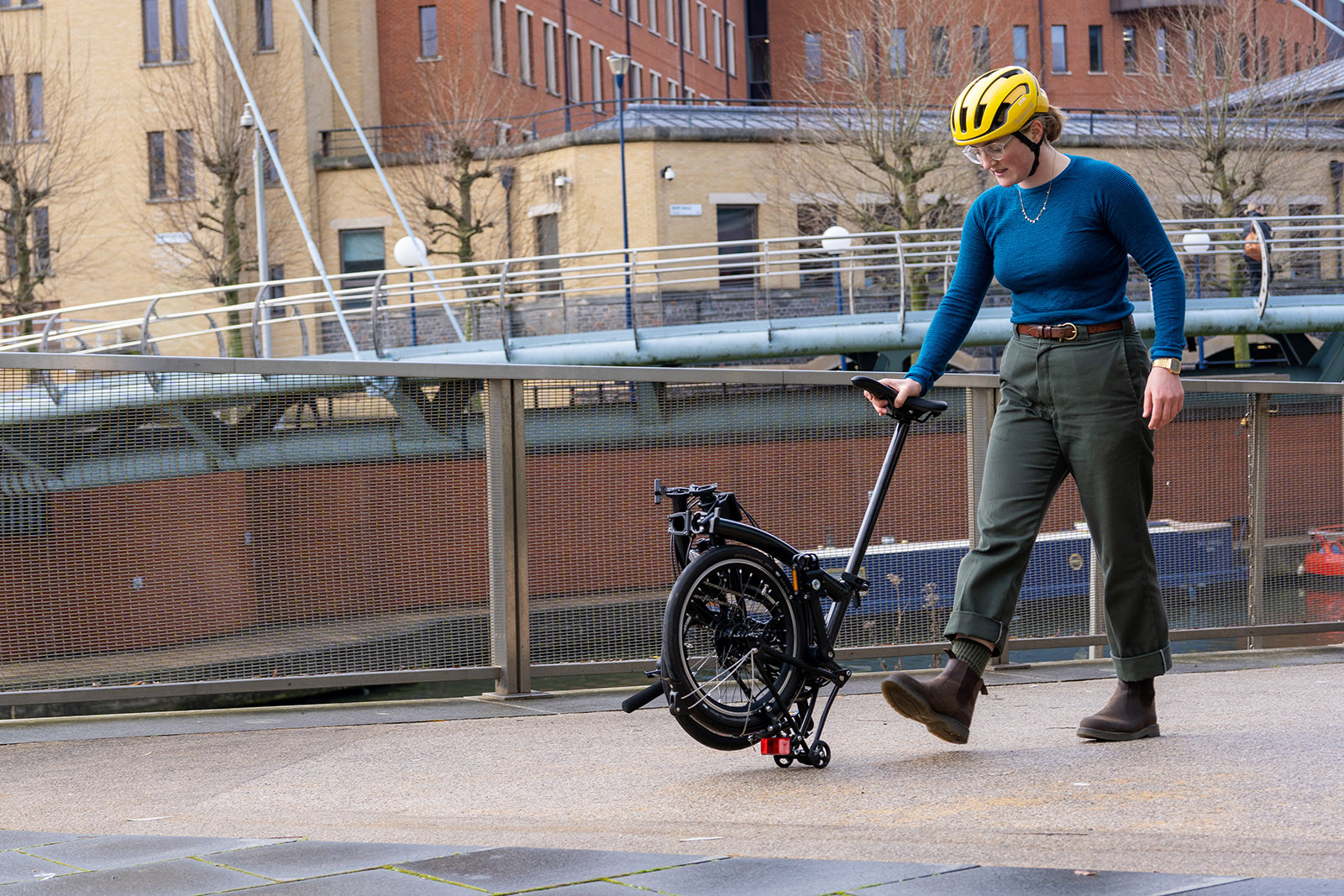 Folding bikes offer the ultimate in urban practicality. – Lucy Rowe / Our Media
Folding bikes offer the ultimate in urban practicality. – Lucy Rowe / Our Media
When is a folding bike most useful? A folding bike is perfect for mixed-mode trips involving trains or limited storage space. They offer unparalleled convenience for urban commuters.
Key features for folding bikes:
- Compact Fold: Allows for easy storage and transport.
- Lightweight Design: Makes carrying the bike more manageable.
- Durable Hinges: Ensures the bike folds and unfolds smoothly.
- Adjustable Components: Provides a comfortable fit for different riders.
- Integrated Features: Such as racks and mudguards for added practicality.
City bikes, or Dutch bikes, are ideal for short, flat rides, while singlespeed or fixie bikes offer simplicity and low maintenance for urban environments.
2. Determine Your Budget
How much should you spend on your first bike? Non-motorized bikes generally start around $200, but higher-quality bikes with better components typically range from $500 to $750.
Consider the following factors when setting your budget:
- Bike Type: Road bikes, mountain bikes, and gravel bikes may have different price ranges.
- Component Quality: Higher-quality components enhance performance and durability.
- Brand Reputation: Established brands often offer better warranties and support.
- Intended Use: Regular use justifies a higher investment for a more durable bike.
- Future Upgrades: Leave room in your budget for potential upgrades and accessories.
Spending between $500 and $750 ensures a durable bike with a well-designed frame and reliable components. If your budget allows, investing around $1,000 can get you quality components and a frame worthy of future upgrades.
3. Choose a Reputable Bike Shop
Where should you buy your first bike? Selecting the right bike shop is crucial. A good shop offers expert advice, proper bike assembly, and post-delivery check-ups.
Look for the following qualities in a bike shop:
- Knowledgeable Staff: Provides guidance without overwhelming you with jargon.
- Wide Range of Options: Stocks bikes from different brands to suit various needs.
- Assembly Services: Ensures the bike is safely and correctly assembled.
- Post-Delivery Check-Up: Offers adjustments and maintenance after the initial purchase.
- Friendly Environment: Makes you feel comfortable asking questions and seeking advice.
A bike shop friendly to beginners will help you navigate options and provide valuable insights into making the best purchase.
3.1 Online vs. Local Bike Shops
What are the pros and cons of buying online vs. local bike shops? Online retailers and direct-sales brands like Canyon and YT Industries offer competitive pricing but lack the personal touch and expert assistance of a local bike shop.
Benefits of buying online:
- Competitive Pricing: Often lower prices due to direct sales models.
- Wider Selection: Access to a broader range of brands and models.
- Convenience: Shop from the comfort of your own home.
Drawbacks of buying online:
- Lack of Personal Assistance: No expert advice or fitting services.
- Assembly Required: Bikes often arrive partially disassembled.
- No Test Rides: Unable to try the bike before purchasing.
- Return Hassles: Potential difficulties with returns and exchanges.
Purchasing from a local bike shop ensures proper assembly, fitting, and ongoing support.
3.2 Second-Hand Bikes
Is it OK to buy a second-hand bike? Buying a second-hand bike can be a cost-effective option, but it requires careful inspection and knowledge of what to look for.
Consider the following before buying a second-hand bike:
- Frame Condition: Check for cracks, dents, or rust.
- Component Wear: Inspect the chain, cassette, and brake pads for wear.
- Proper Fit: Ensure the bike is the right size for you.
- History of the Bike: Ask about any repairs or maintenance performed.
- Test Ride: Take the bike for a test ride to assess its performance.
Usabikers.net offers resources and guides on inspecting and purchasing second-hand bikes to ensure you make an informed decision.
4. Choose Your Gears Wisely
How many gears do you really need on a bike? Modern bikes often have numerous gears, but the key is to ensure the gear range suits your riding terrain.
Understanding gear systems:
- Derailleurs: Mechanisms that move the chain between chainrings and sprockets.
- Groupset: A collection of components including derailleurs, shifters, crankset, cassette, chain, bottom bracket, and brakes.
- Hub Gears: Enclosed gears in the rear hub, offering ease of use and weatherproofing.
- Singlespeed Bikes: Bikes with just one gear, ideal for flat urban areas.
Select a bike with a groupset that matches its intended use. If unfamiliar with gear systems, ask the bike shop to demonstrate how to use the gears and practice in a traffic-free area.
5. Brake Selection
What are the differences between different brake types? While many new bikes now feature disc brakes, understanding the different types is important. Disc brakes offer consistent stopping power, especially in wet conditions, and better control.
Types of brakes:
- Disc Brakes: Provide superior stopping power and modulation.
- Hydraulic Disc Brakes: Offer improved modulation and performance.
- Mechanical Disc Brakes: More common on cheaper bikes, requiring manual adjustment.
- Rim Brakes: Traditional brakes that apply pressure to the wheel rims.
- Cantilever Brakes: Often found on affordable hybrid bikes.
Hydraulic disc brakes are a worthwhile upgrade for enhanced performance.
6. Frame Size
How do you determine the correct frame size for a bike? Getting the right frame size is crucial for comfort and safety. Bike sizes are typically quoted in centimeters, inches, or T-shirt style (e.g., extra-small to extra-large).
Steps to determine the correct frame size:
- Consult Size Charts: Refer to the bike brand’s size chart on their website.
- Measure Your Height: Use your height to find the corresponding frame size.
- Standover Clearance: Ensure a few centimeters of clearance between your body and the bike when standing over the frame.
- Saddle Height: Adjust the saddle height so your knee is nearly straight when the pedal is at the bottom of its rotation.
- Reach to Handlebars: Ensure a comfortable reach to the handlebars, avoiding excessive stretching or cramping.
Usabikers.net provides detailed guides on road bike sizing, mountain bike sizing, and women’s bike sizing to help you find the perfect fit.
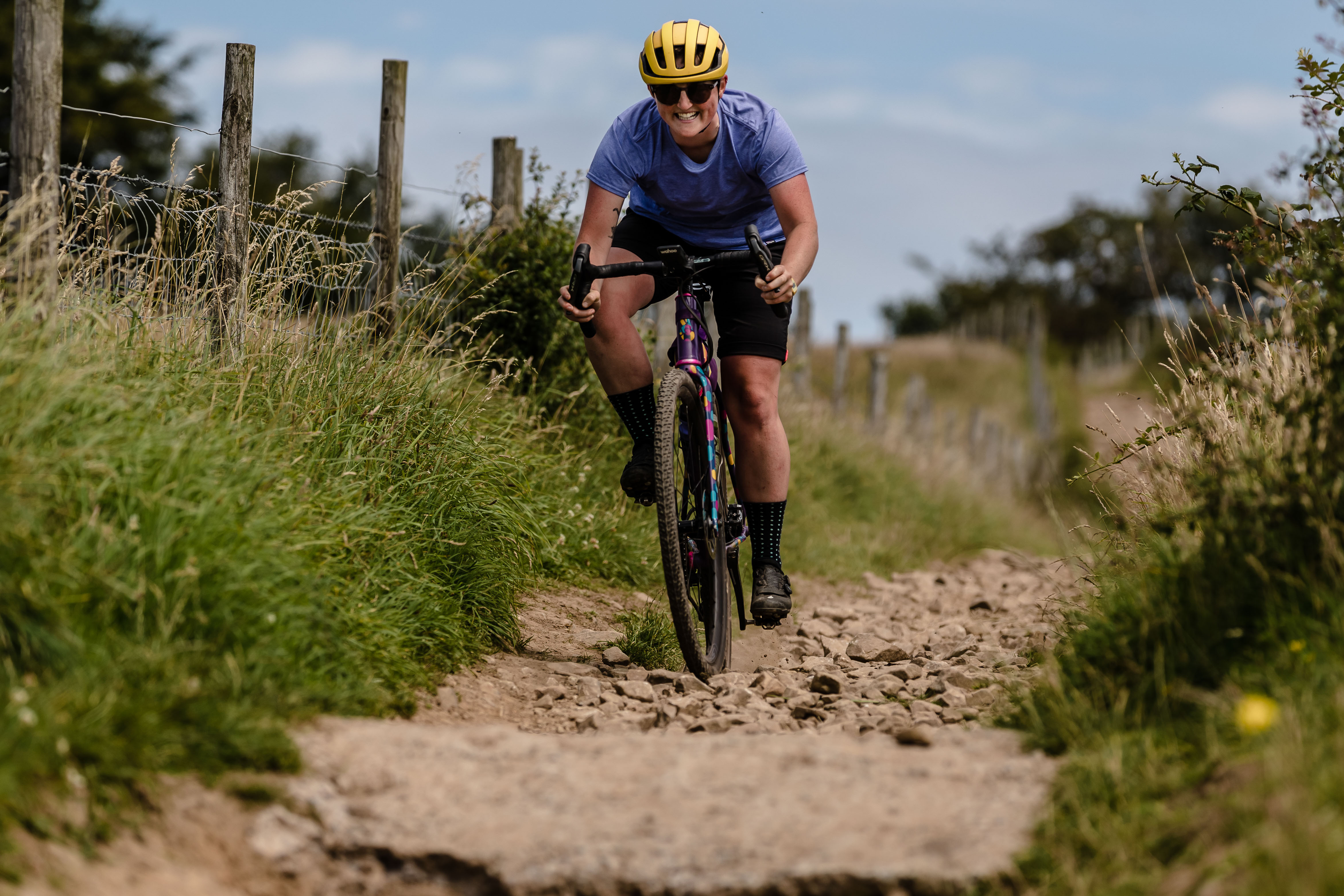 Having a frame that fits you goes a long way to ensuring happiness on the bike. – WTB
Having a frame that fits you goes a long way to ensuring happiness on the bike. – WTB
According to a study by the American Journal of Sports Medicine, a properly fitted bike can reduce the risk of injuries and improve cycling performance.
7. Suspension Considerations
Do you need suspension on your bike? Suspension systems are essential for mountain bikes intended for off-road use. Bikes with front suspension only are called hardtails, while those with front and rear suspension are full-suspension bikes.
Factors to consider:
- Riding Terrain: Determine whether you’ll primarily ride on smooth roads or rough trails.
- Suspension Travel: Choose the appropriate amount of travel based on your riding style.
- Budget: Inexpensive suspension systems may add weight and complexity without providing adequate performance.
For serious off-road riding, mountain bike suspension is beneficial. For hybrid bikes or light trails, wide tires at lower pressure can provide sufficient comfort.
8. The Test Ride
How important is it to test ride a bike before you buy it? A test ride is essential to assess the fit and handling of your potential new bike. Even a short ride around the block can provide valuable insights.
Steps to take during a test ride:
- Check Fit: Ensure the bike feels comfortable and the size is appropriate.
- Assess Handling: Evaluate how the bike responds to steering and braking.
- Test Gears: Shift through the gears to ensure smooth transitions.
- Listen for Noises: Identify any unusual sounds that may indicate mechanical issues.
- Evaluate Comfort: Pay attention to the saddle, handlebars, and overall riding position.
Some bike shops offer longer test rides or demo days where you can ride various models on a set course.
9. Essential Accessories
What essential accessories do you need when buying your first bike? Along with the bike itself, you’ll need several accessories to ensure a safe and enjoyable riding experience.
Must-have accessories:
- Helmet: Protects your head in case of a fall.
- Lights: Enhances visibility in low-light conditions.
- Lock: Secures your bike against theft.
- Pump: Maintains proper tire pressure for optimal performance.
- Repair Kit: Includes essential tools for fixing flats and minor repairs.
- Water Bottle and Cage: Keeps you hydrated during rides.
- Cycling Apparel: Provides comfort and protection from the elements.
According to the National Highway Traffic Safety Administration (NHTSA), wearing a helmet reduces the risk of head injuries by 85 percent.
10. Maintenance Tips
How do you maintain your bike? Regular maintenance is crucial for keeping your bike in top condition and extending its lifespan.
Basic maintenance tasks:
- Clean Your Bike: Regularly clean the frame, components, and chain.
- Lubricate the Chain: Apply lubricant to the chain to reduce friction and wear.
- Check Tire Pressure: Maintain proper tire pressure for optimal performance and safety.
- Inspect Brakes: Check brake pads and cables for wear and adjust as needed.
- Adjust Gears: Ensure smooth gear transitions by adjusting derailleurs.
- Tighten Bolts: Periodically tighten all bolts to prevent loosening.
Usabikers.net offers comprehensive guides and tutorials on bike maintenance to help you keep your ride in excellent condition.
11. Safety Guidelines
What safety precautions should you take when riding your bike? Safety should always be a top priority when cycling. Follow these guidelines to minimize risks and ensure a safe riding experience:
- Wear a Helmet: Protects your head in case of a fall.
- Use Lights: Enhances visibility in low-light conditions.
- Follow Traffic Laws: Obey traffic signals, signs, and lane markings.
- Ride Defensively: Be aware of your surroundings and anticipate potential hazards.
- Use Hand Signals: Communicate your intentions to other road users.
- Stay Visible: Wear bright clothing and reflective gear.
- Maintain Your Bike: Ensure your bike is in good working condition.
The Motorcycle Safety Foundation (MSF) provides extensive resources and training programs to promote safe riding practices.
12. Joining the Biker Community
Why is it important to connect with other bikers? Joining a biker community can enhance your riding experience by providing support, camaraderie, and valuable insights.
Benefits of joining a biker community:
- Shared Experiences: Connect with like-minded individuals who share your passion.
- Group Rides: Participate in organized rides and explore new routes.
- Expert Advice: Learn from experienced riders and mechanics.
- Social Events: Attend events and gatherings to socialize and network.
- Support and Encouragement: Receive motivation and support to achieve your riding goals.
Usabikers.net offers a platform to connect with biker communities, share experiences, and discover new adventures.
13. Understanding Local Traffic Laws
What are the bike traffic laws in my state? Familiarizing yourself with local traffic laws is essential for safe and legal cycling.
Key traffic laws to know:
- Helmet Laws: Determine whether helmets are required for cyclists in your area.
- Right-of-Way Rules: Understand who has the right-of-way at intersections.
- Lane Positioning: Know where to position yourself in the lane for maximum safety.
- Signaling Requirements: Learn the proper hand signals for turns and stops.
- Lighting Requirements: Ensure your bike is equipped with proper lights for night riding.
- Sidewalk Restrictions: Check whether cycling on sidewalks is permitted.
State Departments of Transportation provide detailed information on traffic laws and regulations for cyclists.
14. Conclusion: Your Biking Journey Starts Here
Ready to start your biking adventure? Buying your first bike is an exciting step, and usabikers.net is here to guide you every step of the way. Explore our resources, connect with our community, and embark on a journey filled with freedom, fitness, and unforgettable experiences.
Visit usabikers.net today to discover more and become part of the thriving biker community. With our expert advice and comprehensive guides, you’ll find the perfect bike and unlock a world of adventure.
FAQ: Your Questions Answered
1. What type of bike is best for beginners?
A hybrid bike is often the best choice for beginners due to its versatility and comfortable riding position.
2. How much should I spend on my first bike?
Budget between $500 and $750 for a quality bike with durable components.
3. Where should I buy my first bike?
A local bike shop is recommended for expert advice and proper assembly.
4. How do I determine the correct frame size?
Consult the bike brand’s size chart and ensure proper standover clearance and saddle height.
5. What essential accessories do I need?
A helmet, lights, lock, pump, and repair kit are essential accessories.
6. How often should I maintain my bike?
Perform basic maintenance tasks regularly, such as cleaning and lubricating the chain.
7. What safety precautions should I take when riding?
Always wear a helmet, use lights, and follow traffic laws.
8. How can I connect with other bikers?
Join a local biker community or online forum to share experiences and tips.
9. What are the benefits of an electric bike?
Electric bikes provide assistance while pedaling, making hills easier to climb and long distances more manageable.
10. Is it OK to buy a second-hand bike?
Yes, but carefully inspect the bike’s condition and ensure it fits properly.
Address: 801 Sturgis Main St, Sturgis, SD 57785, United States
Phone: +1 (605) 347-2000
Website: usabikers.net

